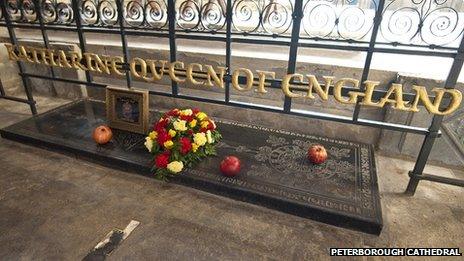Peterborough Cathedral's Spanish queen
- Published

Pomegranates and flowers on Katharine of Aragon's tomb in January 2012
The connection between Peterborough Cathedral and Henry VIII's Spanish queen is little known outside the city.
Katharine of Aragon died at Kimbolton Castle in 1536, and was buried at the cathedral following a lavish funeral.
A festival marks the anniversary of her death and a Catholic mass is celebrated - a rarity in an Anglican cathedral.
This is one of a number of unusual stories to be told in the BBC's People's Passion, which explores the purpose of cathedrals today.
Katharine was cast aside by Henry VIII for being unable to provide the Tudor dynasty with a male heir.

Children taking part in the Katharine of Aragon Festival in January 2012
Stuart Orme, from Vivacity Heritage which co-organises the Katharine of Aragon Festival, said: "She was revered for her piety and dignity.
"Many of the population had a good deal of sympathy for Katharine after the divorce and felt she had been hard done by."
Despite living in reduced circumstances after the end of her marriage, she was given an elaborate funeral on 29 January 1536, involving four bishops and six abbots.
Her tomb was of black marble, with gilded letters and decoration.
Mr Orme said: "But Oliver Cromwell's soldiers stole the gilding during the sack of the cathedral in 1643, while a dean of the cathedral used the marble for the floor of his summerhouse in the 1700s."
'Pomegranate princess'
It was not until the late 19th Century that a wife of one of the cathedral canons, Katharine Clayton, started a public appeal asking all the Katharines of England to donate to the replacement marble slab which can be seen today.

Children learn about Tudor life as well as participating in the festival's civic ceremony
The cathedral now marks the funeral date with the Katharine of Aragon Festival on the Friday and Saturday nearest the 29 January.
A representative of the Spanish embassy is invited to a civic service on the Friday and a Catholic mass is held on the Saturday.
Hundreds of children are encouraged to dress in Tudor costume, and learn how people lived in the early 16th Century from historic re-enactors.
Flowers, and Katharine's heraldic symbol, the pomegranate, are laid upon her tomb.
She had chosen the fruit when she was still a princess in Spain because to the medieval world it symbolised fertility.
- Published25 March 2012